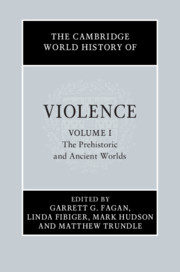Book contents
- The Cambridge World History of Violence
- The Cambridge History of Violence
- The Cambridge World History of Violence
- Copyright page
- Contents
- Figures
- Maps
- Contributors to Volume i
- General Introduction: Violence in World History
- Introduction to Volume I
- Part I The Origins of Conflict
- Part II Prehistoric and Ancient Warfare
- Part III Intimate and Collective Violence
- Part IV Religion, Ritual and Violence
- Part V Violence, Crime and the State
- Part VI Representations and Constructions of Violence
- 29 Kingship, Violence and Non-violence in Indian Thought, c. 500 bce to 500 ce
- 30 Violence and the Bible
- 31 Representations of Violence in Ancient Mesopotamia and Syria
- 32 Representations of War and Violence in Ancient Rome
- 33 Heroism, Military Violence and the State in Ancient India
- Index
- References
30 - Violence and the Bible
from Part VI - Representations and Constructions of Violence
Published online by Cambridge University Press: 13 March 2020
- The Cambridge World History of Violence
- The Cambridge History of Violence
- The Cambridge World History of Violence
- Copyright page
- Contents
- Figures
- Maps
- Contributors to Volume i
- General Introduction: Violence in World History
- Introduction to Volume I
- Part I The Origins of Conflict
- Part II Prehistoric and Ancient Warfare
- Part III Intimate and Collective Violence
- Part IV Religion, Ritual and Violence
- Part V Violence, Crime and the State
- Part VI Representations and Constructions of Violence
- 29 Kingship, Violence and Non-violence in Indian Thought, c. 500 bce to 500 ce
- 30 Violence and the Bible
- 31 Representations of Violence in Ancient Mesopotamia and Syria
- 32 Representations of War and Violence in Ancient Rome
- 33 Heroism, Military Violence and the State in Ancient India
- Index
- References
Summary
How does the Bible represent violence? How does its literary nature shape these representations? How is violence central within biblical theologies? This chapter provides an analytical overview of biblical representations of violence and theorises ‘sanctification’ of violence. Biblical stories feature the range of violence common throughout ancient Near Eastern and Mediterranean societies: war, ritual violence and violence between individuals, both ‘criminal’ and normalised. Socio-narrative context determines the legitimacy or illegitimacy of violence attributed to patriarchs, prophets, priests, Israelites, Judeans, ‘foreigners’ and royals. Some violence follows purported divine directive, but much is mundane. Yhwh’s (or divine subordinates’) violence is typically rendered legitimate. The ‘justness’ of divine violence rhetorically impacts explanations of misfortune: suffering of direct and symbolic violence indicates godly punishment. Within the Hebrew Bible and New Testament the notion that divinely decreed violence accomplishes theistic plans enables misrecognition of ritualised violence. Since antiquity, people have employed biblical themes to claim divine approval of violence. Theorisation of ‘religious violence’ facilitates distinguishing between assertions of biblically ‘justified’ violence versus how the biblical anthology represents violence. Investigating portrayals of violence, especially who benefits and who suffers from each portrayal, is key for examining social impacts of ancient ‘biblical violence’ and modern ‘Bible-based violence’.
Keywords
- Type
- Chapter
- Information
- The Cambridge World History of Violence , pp. 607 - 628Publisher: Cambridge University PressPrint publication year: 2020
References
Bibliographic Essay
- 1
- Cited by

